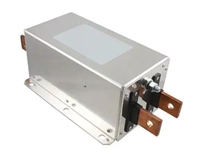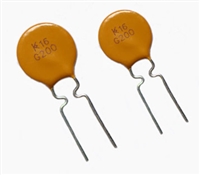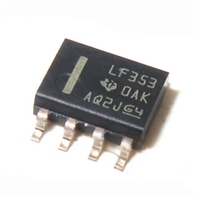AD22100
Due to its limited current sinking ability, the AD22100 is inca-
pable of driving loads to the V+ power supply and is instead
intended to drive grounded loads. A typical value for short-
circuit current limit is 7 mA, so devices can reliably source 1
mA or 2 mA. However, for best output voltage accuracy and
minimal internal self-heating, output current should be kept
below 1 mA. Loads connected to the V+ power supply should
be avoided as the current sinking capability of the AD22100 is
fairly limited. These considerations are typically not a problem
when driving a microcontroller analog-to-digital converter input
pin (see the Microprocessor A/D Interface Issues section).
MOUNTING CONSIDERATIONS
If the AD22100 is thermally attached and properly protected, it
can be used in any measuring situation where the maximum
range of temperatures encountered is between −50°C and
+150°C. Because plastic IC packaging technology is employed,
excessive mechanical stress must be avoided when fastening the
device with a clamp or screw-on heat tab. Thermally conductive
epoxy or glue is recommended for typical mounting conditions.
In wet or corrosive environments, an electrically isolated metal
or ceramic well should be used to shield the AD22100. Because
the part has a voltage output (as opposed to current), it offers
modest immunity to leakage errors, such as those caused by
condensation at low temperatures.
RATIOMETRICITY CONSIDERATIONS
The AD22100 will operate with slightly better accuracy than
that listed in the data sheet specifications if the power supply is
held constant. This is because the AD22100’s output voltage
varies with both temperature and supply voltage, with some
errors. The ideal transfer function describing output voltage is:
THERMAL ENVIRONMENT EFFECTS
The thermal environment in which the AD22100 is used
determines two performance traits: the effect of self-heating on
accuracy and the response time of the sensor to rapid changes
in temperature. In the first case, a rise in the IC junction
temperature above the ambient temperature is a function of two
variables: the power consumption of the AD22100 and the
thermal resistance between the chip and the ambient environ-
ment θJA. Self-heating error in °C can be derived by multiplying
the power dissipation by θJA. Because errors of this type can
vary widely for surroundings with different heat-sinking capaci-
ties, it is necessary to specify θJA under several conditions. Table
6 shows how the magnitude of self-heating error varies relative
to the environment. A typical part will dissipate about 2.2 mW
at room temperature with a 5 V supply and negligible output
loading. Table 6 indicates a θJA of 190°C/W in still air, without a
heat sink, yielding a temperature rise of 0.4°C. Thermal rise will
be considerably less in either moving air or with direct physical
connection to a solid (or liquid) body.
(V+/5 V) × (1.375 V + 22.5 mV/°C × TA)
The ratiometricity error is defined as the percent change away
from the ideal transfer function as the power supply voltage
changes within the operating range of 4 V to 6.5 V. For the
AD22100, this error is typically less than 1%. A movement from
the ideal transfer function by 1% at 25°C, with a supply voltage
varying from 5.0 V to 5.50 V, results in a 1.94 mV change in
output voltage or 0.08°C error. This error term is greater at
higher temperatures because the output (and error term) is
directly proportional to temperature. At 150°C, the error in
output voltage is 4.75 mV or 0.19°C.
For example, with VS = 5.0 V, and TA = +25°C, the nominal
output of the AD22100 will be 1.9375 V. At VS = 5.50 V, the
nominal output will be 2.1313 V, an increase of 193.75 mV. A
proportionality error of 1% is applied to the 193.75 mV, yielding
an error term of 1.9375 mV. This error term translates to a
variation in output voltage of 2.1293 V to 2.3332 V. A 1.94 mV
error at the output is equivalent to about 0.08°C error in
accuracy.
Table 6. Thermal Resistance (TO-92)
Medium
θJA (°C/W)
t (sec)1
Aluminum Block
Moving Air2
6±
2
Without Heat Sink
Still Air
75
3.5
15
If 150°C is substituted for 25°C in the above example, the error
term translates to a variation in output voltage of 5.2203 V to
5.2298 V. A 4.75 mV error at the output is equivalent to about
0.19°C error in accuracy.
Without Heat Sink
19±
Rev. D | Page 8 of 12






 电子元器件中的网络滤波器、EMI滤波器与EMC滤波器:分类关系与功能详解
电子元器件中的网络滤波器、EMI滤波器与EMC滤波器:分类关系与功能详解

 NTC热敏电阻与PTC热敏电阻的应用原理及应用范围
NTC热敏电阻与PTC热敏电阻的应用原理及应用范围

 GTO与普通晶闸管相比为什么可以自关断?为什么普通晶闸管不能呢?从GTO原理、应用范围带你了解原因及推荐型号
GTO与普通晶闸管相比为什么可以自关断?为什么普通晶闸管不能呢?从GTO原理、应用范围带你了解原因及推荐型号

 LF353数据手册解读:特性、应用、封装、引脚说明、电气参数及替换型号推荐
LF353数据手册解读:特性、应用、封装、引脚说明、电气参数及替换型号推荐
